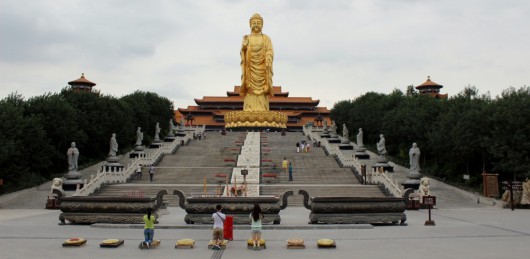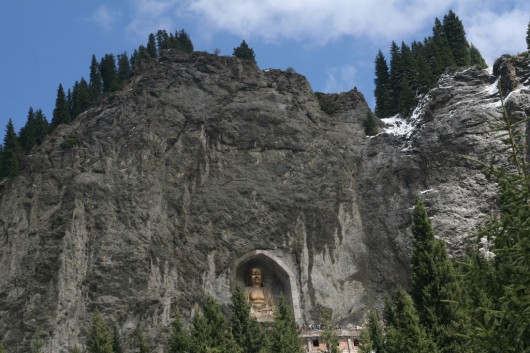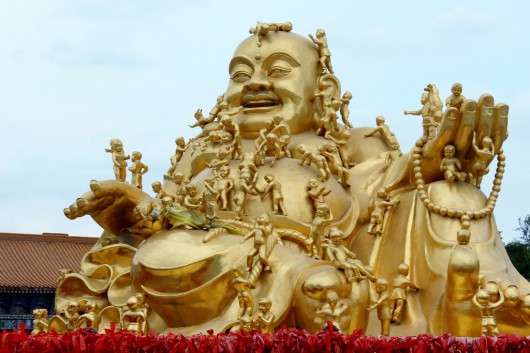
The giant 41-meter Buddha faces due west. It seems to embrace the construction on the other side of Bright Red Mountain on the northeast periphery of Ürümchi. Behind him, the constant ring of hammers and the roar of Bingtuan Construction Engineering Company trucks rise from the still-unfinished wing of the new Hilton hotel and the alien-looking international expo center. Every few minutes the low industrial roar is punctuated by the “dong” of a giant bell. Chants of A-mi-tuo-fo are carried intermittently on the breeze.
The anthropologist Sara Davis argues that giant Buddhas built by Chinese businessmen in the borderlands between Yunnan and Myanmar serve as signals to investors, marking a space as safe and fertile for capitalist success. In Xinjiang, Buddhas do the same – they lay claims to territory and announce the priorities of the state. In a province where it is nearly impossible to build new mosques, giant Buddhas are being given pride of place in prominent public spaces.
The temple complex in Ürümchi is symmetrical. Gates and bridges, fierce gods of war, giant rock gardens made of plaster, hobbit-style caves made of grape arbors, opposing ornate temples filled with auspicious jade from Hotan for middle-class consumers, and matching rows of elephants bearing Tibetan prayer wheels line the causeway. In the center of the complex is a rotund reclining Buddha covered by dozens of naughty golden children. People place their wishes inscribed on red ribbons here. They light incense and bow in four cardinal directions praying for good fortune.
All across northern Ürümchi, Buddhism seems to be on the rise. The small shrine at the main gate of People’s Park now plays Buddhist songs on a constant soundtrack. The old Qing Dynasty temple in Red Mountain is festooned with red ribbons. Buddhism serves many purposes in precarious times. For young crew-cut Han men it appears to give them a sense of martial calm. Rather than wearing the large metal-banded glass-faced watches that mark off aspiring businessmen, they wear prominent strings of beads around their wrists.
In the Giant Buddha complex, this type of masculine Buddhism was less dominant. Instead, there were many families with young children. They seemed really happy that the Jianfu Green Town Real Estate Investment Group had created the complex by donating 300 million yuan. Perhaps the apartment towers of Green Town dominating the near distance compliment their desires for the good life that the mega-temple helps them imagine.
A grandma in one of these families told me they come here occasionally. She was proud that her three-year-old granddaughter was learning how to genuflect and recite the prayers. “This is our history, it’s good that she is learning it,” she said. When I asked how this space compared to other religious spaces nearby, she replied, “Well, the Buddha is big, it’s really the biggest one in the area.” But then she remembered there was another giant Buddha at the Heavenly Lake in the mountains outside of town. I didn’t tell her that there is an even bigger Buddha built into a rock face of the Southern Mountains near the Bingtuan city of Shihezi.

Several years ago I went to see the giant Buddha near Shihezi from Ürümchi. A Kazakh friend who was traveling with us said he felt alienated by the sight of it. It seemed to him that the alpine landscapes which he remembered from childhood visits to extended family were being transformed into a tourist destination. The way the giant Buddha melded with the big concrete yurt at the base of the rock wall made him think that an exotic “Kazakh lifestyle” was being brought into bizarre proximity with alien cultural symbols. Building garish figures out of crumbling concrete was a way of reframing indigenous ways of life.
The people I met on Bright Red Mountain didn’t seem to notice or care about the way their space was connected to global capitalism and Han sovereignty. For them it was a place that allowed them to maintain a sense of security. But maybe in the back of their minds they noticed that the big park was a Uyghur-free space. Unlike signs written in Uyghur and Chinese throughout the rest of the city, in Bright Red Mountain the signs explaining the significance of the sites was written only for a particular audience: Chinese, Japanese, Korean, and English.
In a corner behind the temple to the 500 Arhats and the mural of Journey to the West, a single Uyghur security guard sat making sure that the Uyghur boys playing in the Hilton construction site didn’t jump the gate into the temple grounds. He was listening to Uyghur music on a small handheld radio – carving out a Muslim space behind the back of the Giant Buddha.




Beige Wind runs the website The Art of Life in Chinese Central Asia, which attempts to recognize and create dialogue around the ways minority people create a durable existence, and, in turn, how these voices from the margins implicate all of us in simultaneously distinctive and connected ways.

















































Ironically, the ancestors of Uyghurs were once Buddhists too.
You realize what the Han/CCP practice is not Buddhism at all… rather a “we need to pray at something to get good exam results/wealth/male heir/high paying job/hot mistress, etc.”?
Just look at these vulgar, excessive and utterly tasteless idols coated in gold foil.
操你妈拉个大血屄
Who said these are not Buddhism, you really have no clue what is Buddhism. Praying devas, arhat, bodhisatva for help is just like asking your relatives or close friends to help you. I don’t see anything wrong with that.
Religion isn’t a fixed entity – it evolves and adapts to local cultures. I’m sure the early Coptic Christians would hardly recognize what passes for modern Christianity.
And I’d rather pray for a hot mistress every once in a while than practice symbolic cannibalism every weekend or else be damned to eternal hellfire.
the cross-topic of buddhism in xj needs deeper exploration, though. buddhist interaction in the area goes back some hundreds of years ago – with both Tibetan muslims and Uighur buddhists as a result.
take a look at the little-known salar minority, for example.
this is a topic that goes pretty deep and covers longer history than most are aware!
Pete
This is a really good phrase ‘symbolic cannabilism’.
I really don’t know how singing ‘hallelujah’ and ‘God is great’ every Sunday will enable one to become more ‘holy’. As if almighty God needs some ants to sing how great he is.
Christians may think that all who don’t believe in their God will go to Hell, but Buddha said thousand of years ago, only a rock that is heavy will sink to the bottom, while a leaf that is light will float on top.
The analogy means that bad sins such as killing(terrorism), stealing will make your soul heavier. It’s not which God that you believe in that will make you go to Hell but your deeds or Karma.
The basic concepts of Buddhism are reincarnation, karma and compassionate love and meditation. These basic concepts are missing in many other religions today.
It’s only through compassion, love and meditation that is taught by Buddha can your soul vibration be higher so that you can ascend to higher realms.